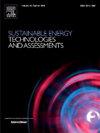A virtual resistance-based pre-synchronization control for grid-forming converters with seamless transfer capability
IF 7.1
2区 工程技术
Q1 ENERGY & FUELS
Sustainable Energy Technologies and Assessments
Pub Date : 2025-04-15
DOI:10.1016/j.seta.2025.104315
引用次数: 0
Abstract
Grid-forming converters (GFMCs) are expected to achieve the seamless transfer between islanded and grid-connected modes. However, the conventional virtual impedance-based pre-synchronization control (VI-PSC) will inevitably introduce a virtual impedance angle, leading to two issues: 1) This angle complicates virtual power estimations; 2) This angle may induce pre-synchronization failure during the transition from islanded mode to grid-connected mode. In this paper, a virtual resistance-based PSC (VR-PSC) is proposed to eliminate the adverse effects exerted by the virtual impedance angle for GFMCs, thereby enabling the reliable and seamless transfer. A comparison between VI-PSC and VR-PSC is conducted from two aspects of virtual power estimations and mapping relations between control targets and results, and then the pre-synchronization failure mechanism caused by virtual impedance angle is elucidated. Subsequently, a single-zero double-pole (SZDP) controller is developed, incorporating a phase margin constraint into its parameter design to avoid the low-pass filter (LPF)-related performance degradation. In this way, even if the LPF is ignored, the developed SZDP can still enhance the dynamic performance of pre-synchronization without compromising the stability of control loop. Finally, the proposed VR-PSC is applied to single and parallel GFMCs respectively, and the performance of VR-PSC is tested by using a hardware-in-the-loop experimental platform.
基于虚拟电阻的预同步控制,适用于具有无缝传输能力的并网变流器
并网变流器(gfmc)有望实现孤岛和并网模式之间的无缝转换。然而,传统的基于虚拟阻抗的预同步控制(VI-PSC)不可避免地会引入虚拟阻抗角,导致两个问题:1)这个角使虚拟功率估计复杂化;2)孤岛模式向并网模式过渡时,该角度可能导致预同步失效。本文提出了一种基于虚拟电阻的PSC (VR-PSC),以消除虚拟阻抗角对gfmc的不利影响,从而实现可靠的无缝传输。从虚拟功率估计和控制目标与结果的映射关系两个方面对VI-PSC和VR-PSC进行了比较,阐明了虚拟阻抗角导致预同步失效的机理。随后,开发了一种单零双极(SZDP)控制器,将相位裕度约束纳入其参数设计中,以避免低通滤波器(LPF)相关的性能下降。这样,即使忽略LPF,所开发的SZDP仍然可以在不影响控制回路稳定性的情况下提高预同步的动态性能。最后,将所提出的VR-PSC分别应用于单个和并行gfmc,并在硬件在环实验平台上测试了VR-PSC的性能。
本文章由计算机程序翻译,如有差异,请以英文原文为准。
求助全文
约1分钟内获得全文
求助全文
来源期刊

Sustainable Energy Technologies and Assessments
Energy-Renewable Energy, Sustainability and the Environment
CiteScore
12.70
自引率
12.50%
发文量
1091
期刊介绍:
Encouraging a transition to a sustainable energy future is imperative for our world. Technologies that enable this shift in various sectors like transportation, heating, and power systems are of utmost importance. Sustainable Energy Technologies and Assessments welcomes papers focusing on a range of aspects and levels of technological advancements in energy generation and utilization. The aim is to reduce the negative environmental impact associated with energy production and consumption, spanning from laboratory experiments to real-world applications in the commercial sector.
 求助内容:
求助内容: 应助结果提醒方式:
应助结果提醒方式:


